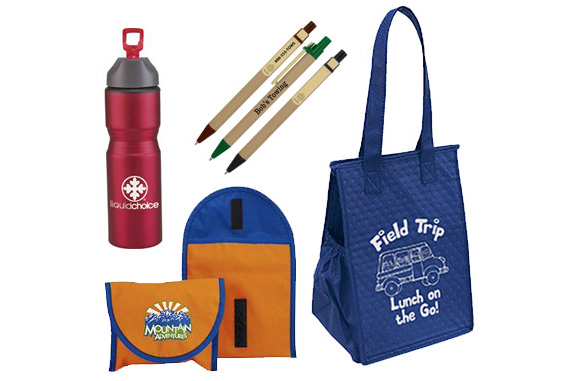Going Green for Back-to-School
by Christine McLean, Eco Promotional Product, Inc.
Once the Fourth of July fireworks have been fired off, it’s time for stores to begin stocking their shelves with back-to-school supplies. Soon the stores will be packed with parents staring down at a long list of supplies needed for their children’s new school year. The National Retail Federation estimated that families with k-12 children spent a total of $26.7 billion in 2013 on back-to-school shopping. While all this money is being spent, school supplies are taking a toll on the environment.
Most school supplies on the market aren’t environmentally friendly. Supplies are bought every year only to end up in a landfill when school is out. Most items can’t be recycled or even reused like broken pens, dried out markers, plastic binders and ripped backpacks. A huge amount of natural resources are used to make these products and wasteful packaging adds to the problem. Luckily, there are many eco-friendly back-to-school items available making all of that spending not quite as wasteful. Here is a list of categories:
WRITING
Pens and Pencils: Purchasing pencils made from post-consumer recycled materials not only saves trees but provides a good end-use for waste newspaper, cardboard, denim, currency and plastic materials that would otherwise end up in a landfill. We also have non-toxic highlighter pens. And don’t forget the eco-friendly zipper pouch to keep all of your items in one place.
Notebooks: Make sure you jot everything down on recycled paper. About 28 percent of all wood cut in the U.S. is used for paper-making. Using recycled paper not only saves trees but statistics from the Environmental Protection Agency show that there is a reduction in air and water pollution when recycled paper is used over new paper. Water pollution is lessened by 35 percent and air pollution is lessened by 74 percent. We have great recycled notebooks that reduce the amount of deforestation that is happening every day.
BAGS
Backpacks and Totes: All students need something to carry their books in. Some choose a backpack and others choose a messenger style bag. Regardless of which you choose, you can get both made out of recycled materials. Tablets are also popular at school. Protect them with a recycled tablet sleeve made of scuba material.
Lunch: Lunch waste is 1/3 plastic, 1/3 paper, and 1/3 food. Start with a recyclable, reusable insulated lunch bag. Switch out the plastic sandwich bags for a reusable sandwich wrap made of recycled bottles and organic cotton. According to Sierra Club, the average family may save about $85 each year by not buying disposable plastic baggies. Beyond cost savings, the production of plastic bags requires petroleum and often natural gas which are both non-renewable resources. Plus, think of all of those plastic bags that won’t end up in a landfill as they can take up to 1,000 years to decompose! By packing waste-free lunches for one month, you will reduce your CO2 emissions by 44.6 lbs.
WATER BOTTLES
It just makes sense to bring a reusable water bottle to school instead of constantly buying single-use plastic water bottles. For one thing, there is a financial savings. The average water pitcher filters 240 gallons of water a year for about 19 cents a day. The same amount of water from bottled water would cost $4.98 a day. And bottled water can be as much as 100,000 times more expensive than tap water. Further, global distribution of water bottles is yet another problem. The trucks, boats and planes that deliver bottled water consume fossil fuels as well as contribute to air pollution.. The earth Policy Institute estimates that the energy used to pump, process, transport and refrigerate bottled water is over 50 million barrels of oil annually. There is also the misconception that these single-use water bottles are recycled into similar products. When they are recovered (and only 29% of 44 billion bottles annually do) the best hope we have is that they be “down-cycled” into other products like doormats, plastic lumber, textiles etc. Still, in the end, these items will find their way to a landfill. Reusable stainless steel water bottles are a great alternative choice.
It is good to note that sometimes you might be able to recycle your own school supplies. Many times children come home on the last day of school with a huge bag loaded from their desk. This might contain unused folders, notebooks etc. that can be used for the next year. Make sure you set them aside or create a school and office supply space where you can store these items. Old pencils can be resharpened or lead in mechanical pencils can be replaced.
Last, there is the issue of what’s popular or trendy with kids. While cute kittens, super heroes and Hello Kitty seem to spark children’s interest, possibly talking to them about the importance of buying recycled items will go a long way. However, not only is recycling and reusing an important issue to discuss but their safety is as well. PVC, one of the most toxic plastics on earth, is abundant in children’s everyday school supplies like book and notebook covers, folders, pencil cases and even lunch bags. Each day at school children are exposed to the toxic phthalates, dioxins and VOC’s released by PVC simply by coming into contact with these items. We have a whole section dedicated to eco-friendly school supplies, so to get more ideas click here. And don’t forget these items are also perfect for the office to help support green business.
Sources: ecology.com, nrf.com, sierraclub.org, plasticpollutioncoalition.org, carbonrally.com, epa.gov, benefits-of-recycling.com



